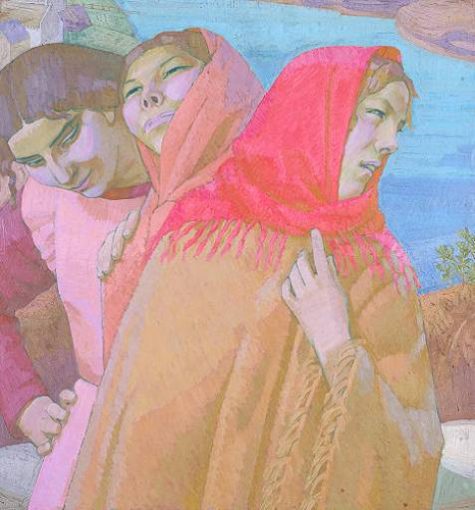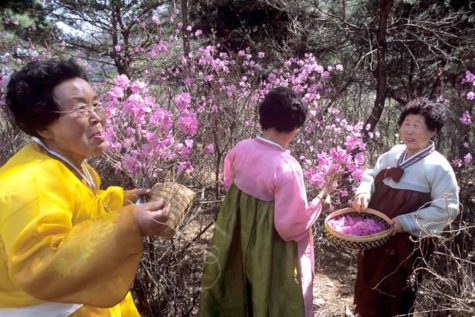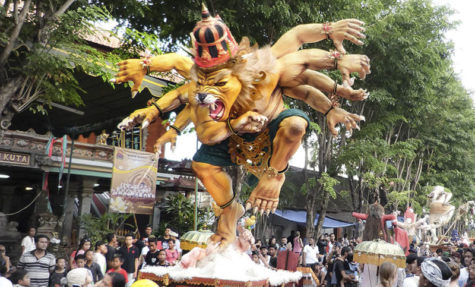March
I found this account of Mother March in an old book about Bulgaria, published in 1877. I love the way they used to celebrate the month of March. It occurs to me that it might be fun and informative to watch the weather this month and assign certain days to certain people and see what happens.
The month of March, which falls in the Spring equinox is called by the Bulgarians, Baba Mart, Old Mother March, and is the only female month of the year, the others being considered as masculine. March in Bulgaria is like April in England, inconstant and capricious, alternating between storms and sunshine; and it is here specially dedicated to the fair sex, who during its continuance enjoy complete idleness, doing no work, and asserting a sort of temporary superiority over their husbands, which sometimes even goes to the length of administering a thrashing, without fear of reprisal.
In order not to displease Baba Mart, the women do not even smear the floors of their houses with clay (a work which is usually performed every week), wash, weave, or spin; for if they were to do so Baba Mart would give no rain during the year, and lightning would infallibly strike the house in which she had been thus insulted.
There are certain clever old women who, knowing where Baba Mart resides, pay her a visit, and from her information assign to each of the married women a day of the month on which the weather will be according to the character of the lady whose day it is; thus, if Mrs. Dimitri gets the 1st of March, it will be fine, with perhaps a warm and gentle shower or two, for she is an amiable and soft-hearted woman, a little give to shedding unnecessary tears upon any pretext. Mrs. Tanaz is a loud-voiced shrew, so her day will be made up of wind, black clouds, snow, and heavy rain. “Don’t go out shooting tomorrow, Chelibi, for it is the day of Kodja Keraz’s wife, and she has such an awful temper that the weather is sure to be horrible.”
When a woman is assigned a day for the first time, her character is judged by the state of the weather; fortunately this system is not extended to young ladies on their promotion, or many a match might be broken off by an inopportune storm in the month of March.
Found in: Twelve Years study of the Eastern Question in Bulgaria
Daeboreum (literally “Great Full Moon”) is a Korean holiday that celebrates the first full moon of the new year of the lunar Korean calendar which is the Korean version of the First Full Moon Festival. This holiday is accompanied by many traditions. The 2017 date is February 11, in 2018 the date is March 2.
Many customs and games are traditional on this day, which is also sometimes called the Great Fifteenth. The Fifteenth, or Full Moon Day, marks the end of the New Year season in Korea and is regarded as the final opportunity to ensure good luck for the coming year.
It is considered lucky on this day for people to routinely repeat their actions nine times—particularly children, who compete with each other to see how many “lucky nines” they can achieve before the day is over.
It is common to celebrate the Great Fifteenth with kite flying and kite fighting, which is done by covering the strings with glass dust and then crossing them so that they rub together as they fly. The string held by the more skillfully manipulated kite eventually cuts through the string of the less successful kite, sending it crashing to the ground.
Another popular sport on this day is the tug-of-war. In some areas, an entire town or county is divided into two opposing teams. It is widely believed that the winners will bring in a plentiful crop and will be protected from disease in the coming year.
One familiar custom is to crack nuts with one’s teeth. It is believed that this practice will help keep one’s teeth healthy for the year.
In the countryside, people climb mountains, braving cold weather, trying to catch the first rise of the moon. It is said that the first person to see the moon rise will have good luck all year or a wish will be granted.
People play the traditional game named Jwibulnori (쥐불놀이) the night before Daeboreum. They burn the dry grass on ridges between rice fields while children whirl around cans full of holes, through which charcoal fire blaze. These cans fertilize the fields and get rid of harmful worms that destroy the new crops.
For breakfast, a five-“grain” rice consisting of rice, millet, Indian millet, beans, and red beans is served (gok includes grains and beans). This is eaten with various dried herbs. One of the special foods of Daeboreum is Yaksik (약식 / 藥食). This treat is made of glutinous rice, chestnuts, pinenuts, honey, sauce, and sesame oil.
Also there is wine drinking for Daeboreum. It called ‘Ear-quickening wine (귀밝이술)’. This alcohol means that if someone drank this alcohol, he or she would be quick to hear and hear good news for one year.
On this day, Koreans traditionally do not give any food to dogs since it is believed that dogs that eat on this day will contract gad flies and become ill during the coming summer.
Sources: Wikipedia and Answers.com
Samjinnal is a Korean holiday that falls on March 3 of the lunar calendar. Three being a positive number in numerology, this date containing two threes was considered to be highly auspicious. This festive day announces the arrival of spring. By this time, spring is usually in full bloom – the weather is warm, the young grass is a lively green, and the first flowers are blooming.
Note: Because this holiday is based on the lunar calendar, on Gregorian Calendars the date will vary from year to year. In 2016, this holiday was celebrated on April 9th, in 2017, this holiday falls on March 30.
It is known as the day the swallows came back from Gangnam and the day the snake came out from its winter sleep. It is also the day birds and butterflies start to appear.
Koreans believed that swallows left for their southward journey on ninth day of the ninth lunar month and returned back on Samjinnal. They started to repair their old nests under the eaves or built the new ones to hatch their young.
Many seasonal activities associated with spring took place on this day. Villagers headed out on a blossom tour of the nearby mountains as the gardens were increasingly frequented by butterflies, fresh-green buds became visible on tree branches and the hills and prairies put on their colorful spring dresses.
Popular picnic foods included flower petal pancakes and other seasonal delights. Banquets were also held around this time of year to treat senior members of the community to special meals. For the noblemen across the country, Samjinnal was a day of archery contests.
Flower petal pancakes for the blossom picnic were made with glutinous rice batter, formed in circles, fried in a pan with sesame oil and topped with azalea petals. A special dessert known as hwamyeon was prepared by putting slices of mung-bean dough cakes into omija (favor flavor berries)-scented water, and flavoring it with honey and pine nuts. When preparing the mung bean dough for this dessert, housewives sometimes added azalea petals to it. If they made the dough with honey and dyed it red, the dish would be called sumyeon.
Sumyeon was considered a ritualistic dish as it was frequently used for memorial services.One of the beliefs associated with Samjinnal is that seeing a white butterfly on that day was an ominous sign since white signifies mourning. The sighting of a white butterfly could result in a family member dying during the course of the year.
Tiger or yellow butterflies on the other hand were considered an excellent sign, and portended a lucky year. Women made sure they washed their hair on Samjinnal as they believed it would make their hair vigorous and beautiful throughout the year. Snakes that came out of their hibernation around that time were avoided at all costs since seeing these slithering creatures was regarded as unlucky.
Other names for this holiday:
It was called samjil (삼질) in oldKorean language and referred to as sangsa (상사, 上巳), wonsa (원사, 元巳), sungsam(중삼, 重三), sangje (상제, 上除) or dapcheongjeol (답청절, 踏靑節) in hanja. Samjinnal implies the overlapping of Sam (three). According to Choi Namseon, samjil was derived from the consonants of Samil, and Sangsa is defined as the first snake day of the 3rd lunar month.
Source: Wikipedia and Encyclopedia of Korean Folk Culture
March 29 thru 31, the last three days of March, have a reputation for being stormy. Scottish folklore proposes that these three days were borrowed from April so that March might extend his power.
The Spanish story about the borrowing days is that a shepherd promised March a lamb if he would temper the winds to suit the shepherd’s flocks. But after his request was granted, the shepherd refused to deliver the payment. In revenge, March borrowed three days from April, in which fiercer winds than ever blew to punish the deceiver.
March borrowit from April
Three days, and they were ill:
The first was frost,
the second was snaw,
The third was cauld as ever’t could blaw.
~ Scottish proverb
From Almanac.com
Toward the end of March, the people of Tibet had a ceremony to expel the demons of bad luck from their homes, lives, and communities. The people of Bali, which is east of Java, also hold public expulsions of demons at least once a year, and on a new moon.
Each village sets food at the nearest crossroads and then goes to the local temple. Everyone prays and blows horns to summon the demons. Then people begin to bang on anything that will make a loud noise, thus frightening the entities which flee the area.
The demons can’t resist the food, pause at the crossroads, and are ambushed by a priest who curse them. This final ambush causes the evil demons to leave the area, and order is restored.
You can duplicate this ritual at home by leaving food on your front doorstep. The food is not going to come back into your home – so leave it on a paper plate instead of your good china.
Then go through the house, calling and whistling to summon the demons. You will want to sound very musical and inviting. Flutes and pan pipes were often used for this purpose.
When you have gone through every room of your home, and you feel that you have attracted the attention of every bad spirit in your home, suddenly begin banging on pots and pans making a loud noise. Have someone stationed at the door, and when the loud noise begins, have them open the door.
The noise will frighten them, but the bad luck entities of the house won’t be able to resist stopping for the food. Now, use this charm to send them packing:
Off with you spirits of fear, spirits of poverty, spirits of evil, spirits of anger, spirits of unhappiness, spirits of pain, spirits of death.
(You can add to this list and personalize it as much as you’d like.)
Repeat three times – each time louder and more commanding than the last.
Give way to the sun, and the moon,
For this is a sanctuary,
This is a place made safe.
Repeat three times – starting with a loud commanding voice and then diminishing in volume but increasing in determination.
Now, very dramatically and decisively, shut the door and lock it. Say:
Blessings and peace upon us,
Blessings and peace.
Repeat three times – smiling.
Very Important:
Do not bring the food you left on the doorstep back into the house, rather, take it away and leave it in a dumpster or put it by a crossroads not close to your home.
Note: This post was put together by Shirley Twofeathers for Gypsy Magic, and has been moved to my new website, here at shirleytwofeathers.com. You may repost and share without karmic repercussions only if you give me credit and a link back to this website. Blessed be.
- Themes: Air, Health
- Symbols: A Pot; Turquoise; Musk; a Star; Wind; Cow Images
- Presiding Goddess: Nut
About Nut:
This great Egyptian sky goddess bears a star spangled belly that stretches over the earth like a protective atmosphere. Today she breathes on us with a late March zephyr bearing health and well being.
Legend tells us that when Ra went to escape the earth, Nut offered her aid by becoming a huge cow who lifted him into heaven. When Nut found herself dizzy from the effort, four gods rushed to her aid. They later became the four pillars of creation – the four winds.
To Do Today:
If the weather permits, I highly recommend a brisk, refreshing walk. Breathe deeply of the air, which has rejuvenating healthy energies today. As you exhale, repeat the goddess’s name, Nut, and listen as she responds in the breeze.
Any type of wind magic honors Nut, and it is certainly fitting today. If the wind blows from the west, sprinkle water into it for emotional healing. If it blows from the east, toss a feather out so it can return to you with healthy outlooks. If it blows from the north, sift a little soil into the wind to give fruitful foundations to a generating idea, and if it blows from the south, burn musk incense to manifest vital energy and a little passion.
From: 365 Goddess
Note: I personally think that any day is a good day to go outside and smell the breeze. The simple wind magicks mentioned here are also effective at any time and in any place.
Today (March 26) marks the beginning of the plowing season in Slavic regions. Before this date the earth is regarded as pregnant. It is a crime against nature and Leshachikha to plow the soil with iron tools when it till bears a magical child (spring). Once earth has given birth, the fields can then accept new seed, which the birds will also appreciate!
From 365 Goddess, we have this way to celebrate the day:
- Themes: Earth; Nature; Harvest; Birth; Protection
- Symbols: Soil; a Leaf; Seeds
- Presiding Goddess: Leshachikha
About Leshachikha: A goddess who sometimes appears as a Slavic forest, a wild animal, or a leaf, Leshachikha is said to have died in October and revived around this time in spring. She fiercely protects her lands, not taking kindly to any who abuse them. In this manner she teaches us about reciprocity and nature’s fury. Additionally, Leshachikha’s watchful aspect can be applied to our figurative lands – for example, safeguarding our homes.
To Do Today:
Go to a nearby field or park today and scatter some seed to Leshachikha to greet her as she awakens.
Whenever you need a little extra protective energy, pick up a fallen leaf and put it in your pocket. This will keep Leshachikha’s guardian powers with you all day. To bring that protection into your home, wax the leaf to preserve it, symbolically sustaining the magical energy forever. Put the waxed leaf near your entryway or in the room where you spend the most time.
The month of March was the traditional start of the campaign season, and the Tubilustrium was a ceremony to make the army fit for war. It was held on March 23, the last day of the Greater Quinquatrus (the festival of Mars and Minerva), and it occurred again on May 23.
The sacred trumpets (tubae) were originally war trumpets, but later they were used for ceremonial occasions. It is not clear if the army was involved, or if it was merely a ceremony to purify the trumpets used in summoning the assembly on the following day.
The ceremony was held in Rome in a building called the Hall of the Shoemakers (atrium sutorium) and involved the sacrifice of a ewe lamb. Romans who did not attend the ceremony would be reminded of the occasion by seeing the Salii dancing through the streets of the city.
Found at: Wikipedia
The Quinquatrus (March 19 through March 23) was named for the fact that it was the fifth day after the Ides (by the Roman method of inclusive counting), but popularly it came to be regarded as a five-day holiday in honor of Mars.
It marked the start of the traditional campaign season for the army. The day also became a feast day for Minerva, despite any clear link between the two deities. (The reason probably was that Minerva’s temple on the Aventine was dedicated on that day.) It seems that women were accustomed to consult fortune-tellers and diviners upon this day.
This primary festival of Minerva was mainly celebrated by artisans but also by students. Minerva, was the virgin goddess of poetry, medicine, wisdom, commerce, weaving, crafts, the arts, dyeing, magic, science, and the inventor of music. She is often depicted with her sacred creature, an owl, which symbolizes her ties to wisdom. March 23, Day of Artisans, is specifically dedicated to her.
 As Minerva Medica she is the patroness of physicians. Minerva is believed to be the inventor of numbers and musical instruments. She is thought to be of Etruscan origin, as the goddess Menrva or Menerva. Later she was equated with the Greek Athena and as such is also sometimes associated as a Goddess of war.
As Minerva Medica she is the patroness of physicians. Minerva is believed to be the inventor of numbers and musical instruments. She is thought to be of Etruscan origin, as the goddess Menrva or Menerva. Later she was equated with the Greek Athena and as such is also sometimes associated as a Goddess of war.
She is the daughter of Jupiter. In the temple on the Capitoline Hill she was worshiped together with Jupiter and Juno, with whom she formed a powerful triad of gods. Another temple of her was located on the Aventine Hill. The church of Santa Maria Sopra Minerva is built on one of her temples.
Source: Pantheon.org
In Bali, the last day their 210 day Saka calendar marks the Balinese feast of purification. This is the time of the year when the lord of hell cleans out his underworld lair, and all manner of demons and evil spirits are left to roam Bali free.
During this time….when evil is afoot……the natives go to elaborate lengths to purify both their individual homes as well as the island. No corner or stone is left untouched as rites of purification and spells for protection are recounted
On this Saka New Year’s Eve, it is all blaring noise and merriment. Every Balinese household starts the evening with blessings at the family temple and continues with a ritual called the pengrupukan where each member participates in ‘chasing away’ malevolent forces, known as bhuta kala, from their compounds – hitting pots and pans or any other loud instruments along with a fiery bamboo torch.
These ‘spirits’ are later manifested as the ogoh–ogoh to be paraded in the streets. As the street parades ensue, bamboo cannons and occasional firecrackers fill the air with flames and smoke. The Nyepi Eve parade usually starts at around 19:00 local time.
This date varies from year to year, in 2019, it falls on March 6. It is based on the Saka calendar of western Indian origin, one among the many calendars assimilated by Indonesia’s diverse cultures. The Saka is 78 years behind the Gregorian calendar, and follows a lunar sequence.
If you’d like to honor this tradition, here is a simple house cleansing ritual:
You will need a broom, some sea water, or rain water with some sea salt dissolved in it, and an Asperger (optional). Open all the windows and doors in your house and starting from the center sweep the whole house. Move Deosil (clockwise) as much as possible. As you go, visualize all negativity as a wispy grey cloud which you are driving out through the windows and doors.
Now take your salt water (and Asperger if you have one) and sprinkle the salt water around the boundaries of your whole home, making sure that you include the sills of all the doors and windows. Be very careful not to make everything too wet, or to sprinkle any electrical equipment, switches or sockets, etc.
As you do each door or window say: “I mark this boundary that no negativity be allowed to enter here. Blessed be.” and then close it.
If the weather is really inclement you may need to work room by room rather than doing the whole house in one go. In this case make sure you cover the boundaries between rooms and any passageways, stairs, etc. without windows.
Note: This house cleansing ritual can be used at any time.
Whenever you move into a new home it is as well to cleanse it to remove any residual negative energies which may have been left behind by the previous occupants. You may also like to do this after any period of upset in your home to thoroughly drive out the problem, or if you have been visited by someone who seems to have left some of their negativity behind them.
Sources:















